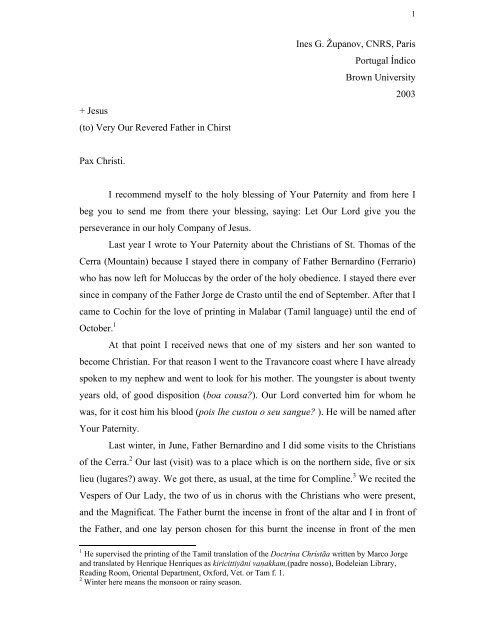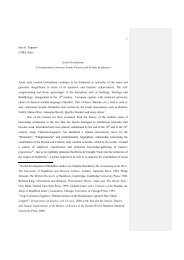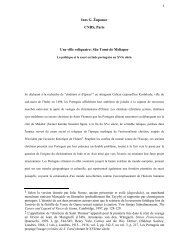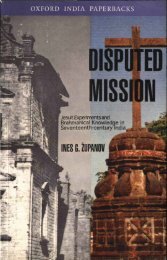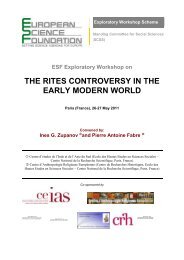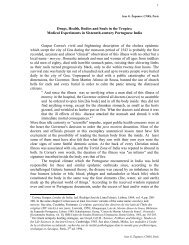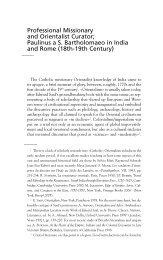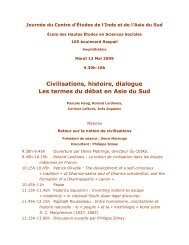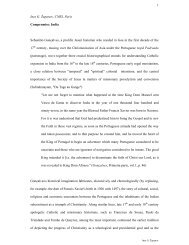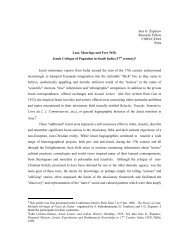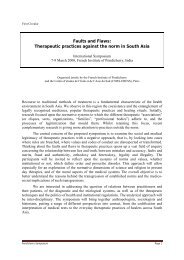Ines G. Županov, CNRS, Paris Portugal Índico Brown University ...
Ines G. Županov, CNRS, Paris Portugal Índico Brown University ...
Ines G. Županov, CNRS, Paris Portugal Índico Brown University ...
You also want an ePaper? Increase the reach of your titles
YUMPU automatically turns print PDFs into web optimized ePapers that Google loves.
1<br />
+ Jesus<br />
(to) Very Our Revered Father in Chirst<br />
<strong>Ines</strong> G. <strong>Županov</strong>, <strong>CNRS</strong>, <strong>Paris</strong><br />
<strong>Portugal</strong> <strong>Índico</strong><br />
<strong>Brown</strong> <strong>University</strong><br />
2003<br />
Pax Christi.<br />
I recommend myself to the holy blessing of Your Paternity and from here I<br />
beg you to send me from there your blessing, saying: Let Our Lord give you the<br />
perseverance in our holy Company of Jesus.<br />
Last year I wrote to Your Paternity about the Christians of St. Thomas of the<br />
Cerra (Mountain) because I stayed there in company of Father Bernardino (Ferrario)<br />
who has now left for Moluccas by the order of the holy obedience. I stayed there ever<br />
since in company of the Father Jorge de Crasto until the end of September. After that I<br />
came to Cochin for the love of printing in Malabar (Tamil language) until the end of<br />
October. 1<br />
At that point I received news that one of my sisters and her son wanted to<br />
become Christian. For that reason I went to the Travancore coast where I have already<br />
spoken to my nephew and went to look for his mother. The youngster is about twenty<br />
years old, of good disposition (boa cousa?). Our Lord converted him for whom he<br />
was, for it cost him his blood (pois lhe custou o seu sangue? ). He will be named after<br />
Your Paternity.<br />
Last winter, in June, Father Bernardino and I did some visits to the Christians<br />
of the Cerra. 2 Our last (visit) was to a place which is on the northern side, five or six<br />
lieu (lugares?) away. We got there, as usual, at the time for Compline. 3 We recited the<br />
Vespers of Our Lady, the two of us in chorus with the Christians who were present,<br />
and the Magnificat. The Father burnt the incense in front of the altar and I in front of<br />
the Father, and one lay person chosen for this burnt the incense in front of the men<br />
1 He supervised the printing of the Tamil translation of the Doctrina Christãa written by Marco Jorge<br />
and translated by Henrique Henriques as kiricittiyāni vaïakkam,(padre nosso), Bodeleian Library,<br />
Reading Room, Oriental Department, Oxford, Vet. or Tam f. 1.<br />
2 Winter here means the monsoon or rainy season.
2<br />
and women who stood separated from each other. When the Compline was finished I<br />
gave a short homily (praticazinha) in which I explained the procedure of the<br />
Company whose sons we are, and that we came to this place with the permission of<br />
their prelate, the Archebishop Mar Abraham, the Catholic who had been to Rome at<br />
the time of the pope Pius V.<br />
After that we invited them all for the next day Mass and Sermon, which I did<br />
during the offertory in Malabar language, which is my native tongue. 4 They rejoiced<br />
in this and after that I baptized their children for free, because their (priests) charge<br />
money for this. They were very satified and surprised that we do not accept anything<br />
from them. They sent us chicken, figs and invited us to eat, and accompanied us from<br />
one place to another with pleasure. 5 They gave us their churches to stay in them and<br />
their treasury to establish fabricas in them. 6 They brought their sons to us to teach<br />
them Latin. This happened in all the places.<br />
Our Lord saw how satisfied we were and wanted to test how firm was our<br />
faith. He wanted especially to test me, who lacks it (faith). I hope that God would give<br />
me more through the prayers of Your Paternity. What happened is that a big storm<br />
came over a large river (while we were) in a small boat, with big rain and wind. Even<br />
in this there was a great mercy of God in that they blew into the poop (of the boat).<br />
We held on and the boatman steered from the poop and I from the prow, and finally,<br />
all drenched we reached an island at night. Certainly, my Father, I was worried for<br />
Father's life (Ferrario) because he does not know how to swim. This is good to know<br />
for all of ours out there (in Europe), especially for those that are to come here. I can<br />
swim and thought of holding on to the boat which was all flooded until coming<br />
ashore, but Our Lord released me from everything due to merits of to the holy Fathers<br />
and Brothers of the Company (of Jesus), to whom glory and honor.<br />
One of the good things done by Father Visitor Alessandro Valignano was to<br />
use these Christians, according to the intention of Your Paternity. They feel well with<br />
us. They demand us from all places and they are happy with our manner of<br />
proceeding. Last year I wrote to Your Paternity that I had two (more) children to<br />
3 Compline or Completas in Portuguese and Completorium in Latin is the last of the canonical dayhours<br />
before retiring for the night.<br />
4 Here Malabar language stands for Malayalam, Pero Luís's native tongue. On other occasions, Malabar<br />
language stands for Tamil.<br />
5 What kind of fruit is fig in this context is uncertain. It is possible that he means bananas, which are<br />
usually offered and were called in Portuguese Indian figs (figos da India).<br />
6 To establish fabrica means here to take over the temporal administration of the church
3<br />
baptize, of whom this year when I did my visit by the order of the holy obedience I<br />
baptized one who was six years old and the other who was three. Certainly, one<br />
should feel pity for those who died here without baptism.<br />
These Christians of the Cerra, it seems to me, live on the territory of some fifty<br />
leagues long and their settlements are about three or four (square) leagues in surface<br />
when big and half a league when small. If eight fathers of the Company who know the<br />
language come here, in a short while these Christians would be brought under<br />
obedience. And for this a rent of a thousand pardaos would not be necessary.<br />
If I could only be among those rich, rich gentlemen Cardinals and the<br />
gentleman Marco Antonio Colona and other similar to tell them about how they spend<br />
a lot there for things that are of no service to God, as is the one for the souls for which<br />
Christ suffered. That a black person with his ears pierced and whose dead parents are<br />
in hell should tell all this may move a lot. On the other hand, it seems to me that even<br />
if Lazarus were to be resuscitated, little would be done. As soon as I would finish<br />
saying this in Rome, I would like to see myself in India. Forgive me Your Paternity<br />
on this imprudence of mine.<br />
I also wrote to Your Paternity that I have a Christian brother and three<br />
nephews and now hope that one of my sisters would come with her son who is twenty<br />
years old. I asked that he be given a post of lingoa in Kollam and Kayankulam, that is,<br />
to be interpreter. This is a good job for them and with this they left me because until<br />
then my relatives pestered me and I pestered the Fathers. If your Paternity could write<br />
to <strong>Portugal</strong> to the Fathers to obtain from the King this job of interpreter in Kollam and<br />
Kayankulam for my brother and my nephew, each could be placed in one or the other<br />
according to the wishes of the Fathers and myself.<br />
News about me: physically healthy, lacking all kinds of virtues. Recommend<br />
myself to Your Paternity's blessing.<br />
From Kollam, today, January 6, 1580.<br />
Your Paternity's unworthy son<br />
Pero + Luís<br />
When I have already finished writing this letter, I received one letter from<br />
Your Paternity, written on October 19, 1578, with which my poor soul was so greatly<br />
consoled that I cannot express it. Now I have a reason to have hope that Our Lord will
4<br />
forgive my sins and will give me his grace since Your Paternity remembers to console<br />
me without knowing me (in person) and without my writing to you. May Our Lord<br />
pay Your Paternity for this mercy.<br />
It is very good from His Sanctity (the pope) to write to the Archbishop of<br />
Angamele that he should be present at the Provincial Synod, but he was so<br />
scandalized with what they did to him the last time. I believe, however, that he will go<br />
to it either in person or, if no, will send his procurator, which is good for now.<br />
Archdeacon is also a good man, and it would be good if he succeeds Archbishop in<br />
his office (prelacy). Both are truly our friends.<br />
I spoke here with some senior Fathers and with the Father Visitor about how<br />
good it would be to admit some Syrians into the Company and make them Catholic<br />
and then His Sanctity could ordained them as bishops and send them here. Or, (it<br />
would be good) if some Brothers of the Company learn Syrian well, are ordained and<br />
sent here. All this should be done through Patriarch of Babylon from where these<br />
bishops come. This would be a good way for reducing them (to obedience) quickly,<br />
because he has to enter with his and come our with ours. May your Paternity receive<br />
these liberties from an undisciplined subject with the spirit of paternal clemency. I<br />
recommended myself again and again to the holy blessing of Your Paternity.<br />
Date above.<br />
Your unworthy son<br />
Pero + Luís<br />
Source:<br />
Original autograph of the letter is in Archivum Romanum Societatis Iesu, Goa 13 I, ff.<br />
1r-2v.<br />
Published version in Joseph Wicki, S.I., (editor), Documenta Indica, Institutum<br />
Historicum Societatis Iesu, Rome, vol. 11, 1970, pp. 789-794.
5<br />
Christian self-fashioning in India<br />
The writer of this letter written on January 6 of 1580 in the Jesuit residence in<br />
Kollam, a town in what is today the Indian state of Kerala, is Pero Luís Bramane, the<br />
only Indian Jesuit to be admitted to the Society of Jesus until its suppression in 1773.<br />
His exceptional Jesuit biography can be pieced together from information scattered<br />
through the correspondence of other Jesuits who worked closely with him in the<br />
southern Indian missions and from his five extant letters. Born a Brahman in a village<br />
near the city of Kollam, he converted to Christianity in 1546 when he was about<br />
fifteen years old. 7 From that time until 1561 the Jesuits employed him as a língua or<br />
interpreter for Malayalam, his native tongue, and Tamil, another South Indian<br />
language. He was, of course, proficient in Portuguese and when he wrote his first<br />
letter in 1559 to the General of the Society of Jesus in Rome, Diogo Laínez,<br />
expressing his desire to join the Society, his language and rhetorical skills were<br />
clearly as good, if not better, than of an average Jesuit corespondent. 8 In 1561, he was<br />
admitted to the Society of Jesus as a novice and continued to study at the St. Paul's<br />
College in Goa. However, from early on, due to his superior linguistic skills, his<br />
education in Jesuit institutions was often interrupted by urgent missions, either to<br />
serve as interpreter for important Jesuit figures such as António Gomes or to help out<br />
with the fathers during the "confession season" (Lent) in the mission on the Fishery<br />
Coast. Thus, it took him an unusual time of ten years to finish his studies and to be<br />
ordained as priest in 1575.<br />
Eight years before his ordination, he was already an experienced missionary<br />
and a cherished member of the famous Jesuit mission among the Parava pearl-fishing<br />
community on the Fishery Coast, established by Francis Xavier in the early 1540s.<br />
Among the tasks he regularly performed there, he was especially hailed as an<br />
excellent preacher. Thus, one of his co-religionist in the field described with<br />
admiration his Passion Sermon in Tamil which caused, in his words, "a big sentiment"<br />
among the people who shed a profusion of tears and were incited to discipline<br />
themselves (i.e. mortify by flogging) until blood dripped from their bodies during the<br />
procession. 9 The people cried so much, continued Diogo do Soveral, that Pero Luís<br />
7 Wicki, Joseph, S.I., (ed.), Documenta Indica (henceforth DI), vol. III, p. 485.<br />
8 DI IV, pp. 392-396.<br />
9 DI VII, p. 178.
6<br />
had to stop the sermon and wait for the silence in order to continue. The power of his<br />
preaching in Tamil transcended linguistic barriers because even the Portuguese who<br />
were present on this occasion were "moved" by the sight of a fervent Christian<br />
devotion of these new Christian communities.<br />
From other Jesuit sources and his own annual report letter from the mission on<br />
the Fishery Coast we can get a clear picture of his incredibly busy schedule that<br />
involved travelling long distances along the coast in order to help the Jesuit fathers<br />
with the ministry of confession which at that time became overwhelming. 10 The<br />
confession movement among the new converts has been recorded almost everywhere<br />
in successful Jesuit missions in India of which the mission among the Christian<br />
Paravas was the most prominent. The reasons for the success of this Christian practice<br />
can be found to a great degree in cultural hybridization, which connected confession<br />
with a pre-Christian practice of ritual possession, an important psychological conduit<br />
in South Indian culture. Contemporary anthropologists still ponder over this<br />
overarching religious manifestation, often defined as a pre-modern manner of dealing<br />
with psychological and communal disorders. South Indian "relational" divinities and<br />
devotional traditions (bhakti) are replete with the energy of possession, which flows<br />
between the humans and the gods. What this energy helps to bring out and articulate<br />
is a word - a word of complaint, distress, accusation and threat. A possessed person,<br />
conceptualized as a receptacle of a divine/demonic power, is generally considered as<br />
speaking the raw truth about the problematic relations beyond direct human<br />
perception. It serves, obviously, as a word of resistance for those who are<br />
disenfranchised by the community, such as women, outsiders, and others. Possession<br />
is also a profession by which shamans and mediums offer solutions and advice to<br />
those who need them.<br />
With confession and other forms of "spiritual practices", the Jesuits provided<br />
an alternative solution to the same cultural problems. 11 Hence, the tears and fervent<br />
mortification combined with an incentive to the neophytes to speak about their most<br />
intimate desires, fears and angers replaced the possession, which the Jesuits branded<br />
as another demonic illusion. It comes as no surprise that the native informants, the<br />
línguas, such as Pedro Luís Bramane were instrumental in guiding the Jesuit search<br />
10 DI VIII, p. 510.<br />
11 Nabokov, Isabelle, Religion Against the Self, An Ethnography of Tamil Rituals, New York: Oxford<br />
<strong>University</strong> Press, 2000.
7<br />
for appropriate cultural idioms in which Christianity could be accepted by the new<br />
converts. He might, thus, appear as a native "collaborator" of the padroado, that is, of<br />
the ecclesiastical and secular Portuguese imperial impulses and intentions. This<br />
particular reading of his role would work fine within an analytical framework - quite<br />
fashionable in the field of social sciences in the closing decades of the twentieth<br />
century - that takes for granted that the conversion in Asia during the 16 th century was<br />
a purely coercive and hegemonic process. As Pero Luís Bramane's life and work<br />
shows, it is an excessively one-sided view.<br />
First of all, he was not simply a "collaborator", the category that points to a<br />
treacherous and spy-like character qualities. He was, on the contrary, a fervent<br />
Christian convert and as true a believer in the Kingdom of Heaven brought closer to<br />
Indian gentiles by the Portuguese as any other European Jesuit. His "interstitial" place<br />
within the administrative and ecclesiastical machine employed by the Estado da India<br />
and complicated by the presence of the transnational religious order such as Society of<br />
Jesus, made him more cognitively alert than his European co-religionists. 12 He<br />
perceived, understood and reacted to ambiguities and inconsistencies inherent in<br />
religious and cultural imperialism willed by the Portuguese in India. It would be<br />
wrong to characterize him as an Indian "nationalist" Jesuit, a contradiction in terms<br />
since an ideal Jesuit was to forsake his country, nation and his family for the "greater<br />
glory of Christ" and espouse a transnational (Christian) identity. He was, however, the<br />
first to notice on his skin how capriciously implemented was this ideal in India. When<br />
he was still a young boy in the Seminary for native students in Goa, one of the rectors<br />
decided to expel all the "natives" on the pretext that they were fit neither for the<br />
European learning nor for priesthood. 13 Later on, the color of his skin was also used<br />
for or against his demand to be admitted to the Society of Jesus. One of his patrons, a<br />
future Jesuit martyr Gonçalo de Sylveira wrote favorably about him, claiming that he<br />
was dark because of the climate, but not black". 14 To be ordained, he had to be,<br />
according to the informal opinion, and after 1585 an official decree, at least thirty<br />
12 12 "Interstitionality" is a concept borrowed from Homi Bhabha. Bhabha, Homi K. The Location of<br />
Culture. London & New York: Routledge, 1994.<br />
13 See my unpublished conference paper on Antonio Gomes, "Ferveurs et tropiques: une carrière<br />
missionnaire en Inde, António Gomes (1548-1554)", conférence internationale, Histoire culturelle et<br />
histoire sociale: les missions religieuses dans le monde ibérique, EHESS/Ecole française de Rome,<br />
<strong>Paris</strong>, May 26, 2000.<br />
14 DI IV, 432.
8<br />
years of age and a Christian for at least fifteen years. 15 This went against the decree of<br />
the Council of Trent allowing ordination at twenty-five. Indian converts were<br />
obviously seen as fragile Christians.<br />
He was also quick to take advantage of and to feed into a number of European<br />
ideas about Indian "gentile" social and cultural institutions. Thus he emphasized his<br />
high-cast pedigree. In a letter to the General of the order written in 1559, Pero Luís<br />
Bramane framed his own individual qualities and special fitness to become a Jesuit<br />
and a priest by indirectly claiming that it was his birthright. "I am a young man, son of<br />
a gentile Brahman (who are like religious among us Christians)". 16 This claim was<br />
surely effective and credible to both Jesuit and Portuguese ears in spite of another<br />
decree by the Council of Trent recommending that the poor and lowly be preferred as<br />
candidates for priesthood. 17 . In the seventeenth and eighteenth centuries in Goa and<br />
elsewhere, Brahmans and high castes were considered as the only "natives"<br />
admissible to priesthood.<br />
Even when priests, "natives" were assigned to subaltern positions within the<br />
Portuguese ecclesiastical system in India since Portuguese clergy would not tolerate to<br />
be bossed over neither by a "native" nor by a "converted Jew or Muslim" priest. Some<br />
of them who went to Rome and impressed the pope and cardinals with their pious<br />
behavior and superior theological knowledge came back to India as bishops sent by<br />
the Congregation of the Propagation of Faith (established in 1622 in Rome). In spite<br />
of the title, they were never allowed to exercise their duties in the padroado territory<br />
and encountered more often persecution and accusations of false representation than<br />
appropriate honors.<br />
Pero Luís Bramane learnt quite early and quickly what were the institutional<br />
limits within which he could or could not act and thrive as a Jesuit missionary.<br />
Evaluations of his pears, either in catalogues written regularly by the superiors or in<br />
individual letters show that he was generally appreciated for his linguistic and social<br />
skills. Not a single "scandal" was ever attached to his name, he was always obedient<br />
and an exemplary Jesuit. But as he grew older and surer of his position, Pero Luís<br />
became more critical of the boundaries imposed on him and his likes.<br />
15 Except for the Syrian Christians. Carlos de Melo, 139<br />
16 Pedro Luís Bramane to Diogo Laínez, Goa, Nov. 1559, ARSI, Goa 10 II, f. 418r.<br />
17 Melo, C. M. de S. J., The Recruitment and Formation of the Native Clergy in India, Lisbon, 1955, p.<br />
139.
9<br />
In this particular letter written in 1580 when his Jesuit career was at its<br />
highest, he shows the first signs of impatience. At this point he was assigned to the<br />
mission among the St. Thomas or Syrian Christians on the south-west coast of India in<br />
the vicinity of Kochi. It was a special mission administered by the Jesuits from around<br />
1577 when a famous Italian Jesuit Alessandro Valignano traveled to the region and<br />
met with the Syrian Archbishop Mar Abraham. These ancient Christians whose<br />
presence in India dated back to the early centuries, were, according to their own<br />
accounts and legends, the descendants of the converts made by St. Thomas the<br />
Apostle. The Portuguese considered them a difficult and disobedient community.<br />
There were doubts about the orthodoxy of their religious practices and their bishops<br />
who were traditionally coming from Mesopotamia and were considered as breaching<br />
the padroado system, in addition to being suspected of Nestorian heresy. Pero Luís<br />
Bramane was handpicked by Valignano to serve as a companion and an interpreter to<br />
other Jesuit fathers sent to the mission. His high status was decisive for Valignano's<br />
selection since the St. Thomas Christians claimed a status similar to that of the highest<br />
caste in the region. that is, such as the Brahmans (religious specialists and<br />
landowners) and the Nayars (the warriors and the kings). Pero Luís Bramane had no<br />
trouble holding on his own there and remained in the mission until, caught between<br />
warring faction, he was attacked and almost died in 1586.<br />
In this letter written a year before attack on his life we see an ordinary<br />
missionary life unfold before our eyes. He traveled a lot from one place to another<br />
since the Christians were scattered in small hamlets and the Jesuits residing in the<br />
mission were never more than two or three at the time. The missionary primary<br />
concern was to teach by word and by example Roman Christian ritual and Catholic<br />
civility which was often contrasted with the customs of the native priests, the<br />
kattanars, accused of simony, immorality (some of them were married) and<br />
ignorance. The technical term used for such a conversion in process was "reduction",<br />
that is, reducing the St. Thomas Christians to the absolute obedience of the Roman<br />
church and the padroado prelates. It turned out to be in the short and in the long run<br />
quite impossible. Without Portuguese direct administrative grasp and without<br />
sufficient funds, as Pero Luís Bramane shrewdly concluded in another letter that the<br />
chances of success were meager: " Nobody confesses the error if not conquered in<br />
conscience or forced. Since we do not have force, it is necessary the other, and for this
10<br />
we need money". 18 We can recognize the method of accommodation in its inception,<br />
although in India, Roberto Nobili would chisel out its fully articulated form a few<br />
decades later, in the early 17th century Madurai Mission.<br />
The question of the scarcity of financial resources made Pero Luís Bramane<br />
play a well crafted "reverse mirror gaze" game on his audience. He half exhorted, half<br />
chastised the "rich, rich Cardinals" in Rome for being stingy and uncharitable. To<br />
make this rhetorical ruse effective he inserted his own stunning self portrait as "a<br />
black man with pierced ears and whose dead parents were in Hell". 19 In spite of the<br />
vestiges of paganism still inscribed on his body, we are meant to understand, that it<br />
was him who worked for Christ in India not them. In the post-script to the letter he<br />
developed yet another proposal to his European superiors in order to finally "convert"<br />
the St. Thomas Christians to Catholicism and wean them from their own bishops<br />
ordained in Syria or by the Syrian prelates. His plan that he shared with other Jesuits<br />
was to admit some of the "surianos"- the term he also applied to local St. Thomas and<br />
not only to "foreign" Syrian bishops - to the Society of Jesus and then send them back<br />
as Catholic bishops. In this way their conversion would follow an exemplary formula<br />
of interior and true conversion postulated by Ignatius of Loyola and evoked by Pero<br />
Luís Bramene, "so that they can enter with their (will) and come out with our<br />
(will)". 20 This formula can be also interpreted as an invitation to indigenize<br />
(inculturating) Christianity and for Pero Luís Bramane it was evident that the first step<br />
to that was "to open the door for those of India" to the Society of Jesus. 21<br />
More than a decade later, when he was an old men and wrote his last letter in<br />
1589, he made one more passionate and somewhat impatient plea for the admission of<br />
the "natives". 22 He complained directly to the Jesuit General, Everard Mercurian<br />
about the fact that he was "the only Malabar son, alone in the Society" and that he<br />
longed for more companions. There was no reason, he claimed, not to admit the<br />
natives of India into the Society of Jesus, as there were many "able people here and<br />
among St. Thomas Christians". Concerning rumors about a dissolute life led by<br />
Malabar clerics, he said, "God is my witness how other nations live".<br />
18 DI XII, 173.<br />
19 Pero Luís to Marcurian, Kollam, 6 Jan., 1580, ARSI, Goa 13 I, ff. 1r-2v.<br />
20 DI XI, p. 794<br />
21 DI XV, 219.<br />
22 DI XV, 219
11<br />
Whatever the case, his solitary voice was not heeded and he remained the only<br />
Indian to be admitted into the Society until its dissolution in 1773.
12<br />
Bibliography:<br />
Bayly, S., Saints, Goddesses and Kings: Muslims and Christians in South Indian<br />
Society, 1700–1900. Cambridge: Cambridge <strong>University</strong> Press, 1992 (Indian ed.).<br />
Boxer, C. R., Race Relations in the Portuguese Colonial Empire. Oxford: Oxford<br />
<strong>University</strong> Press, 1963.<br />
Boxer, C. R., Fidalgos in the Far East, 1550–1770. The Hague: Martinus Nijhoff<br />
(Reprint, 1968, Hong Kong), 1948.<br />
Brou, A., “Notes sur les origines du clergé indigène au pays Tamoul,” Revue<br />
d’histoire des missions, 7/2 (June 1930), pp. 188–210.<br />
<strong>Brown</strong>, L., The Indian Christians of St. Thomas. Cambridge: Cambridge <strong>University</strong><br />
Press, 1982 (1st ed., 1956).<br />
Correia-Afonso, J., S.J., Jesuit Letters and Indian History. Bombay: St. Xavier’s<br />
College, 1955.<br />
Correia-Afonso, J., S.J., Indo-Portuguese History: Sources and Problems. Bombay:<br />
Oxford <strong>University</strong> Press, 1981.<br />
Costa, J. P. O. e, “Os Portugueses e a cristandade siro-malabar (1498–1530),” Studia,<br />
52 (1994).<br />
Coutinho, F., Le Régime paroissial des diocèses de rite latin de l’Inde des origines<br />
(XIVe siècle) à nos jours. Louvain/<strong>Paris</strong>: Publications Universitaires de<br />
Louvain/Béatrice-Nauwelaerts, 1958.<br />
D’Costa, A., Christianization of the Goa Island, 1510–1567. Bombay: St. Xavier's<br />
College, 1965.<br />
Ferroli, D. S. J., The Jesuits in Malabar, 2 vols. Bangalore: Bangalore Press, 1939–<br />
51.<br />
Ghesquière, T., Mathieu de Castro, premier vicaire apostolique aux Indes. Louvain:<br />
Apostolat monastique et missionnaire, 1937.<br />
Gonçalves, Sebastião, S. I., Primeira Parte da Historia dos Religiosos da Companhia<br />
de Jesus e do que fizeram com a divina graça na conversão dos infieis a nossa<br />
sancta fee catholica nos reynos e provincias da India Oriental, (ed. José Wicki<br />
S.I.) Coimbra: Atlântida, Coimbra, 1957-1962.<br />
Gruzinski, S., “Les mondes mêlés de la monarchie catholique et autres ‘connected<br />
histories,’” Annales, 56/1 (Jan.–Feb. 2001), pp. 85–117.<br />
Guerreiro, Fernão, S.I., Relação Annual das Coisas que Fizeram os Padres da<br />
Companhia de Jesus nas suas Missões nos anos de 1600 a 1609, 3 vols., Coimbra:<br />
Imprensa da Universidade, 1929-1942,<br />
Loureiro, R. M., “O descrobrimento da civilização indiana nas caratas dos jesuítas<br />
(século XVI),” in Encontro sobre <strong>Portugal</strong> e a Índia. Lisbon: Fundação<br />
Oriente/Livros Horizonte, 2000, pp. 107–25.<br />
Loureiro, R. M. and Gruzinski, S., eds., Passar as fronteiras: II Colóquio<br />
International sobre Mediadores Culturais, séculos XV a XVIII. Lagos: Centro de<br />
estudos Gil Eanes, 1999.<br />
Melo, C. M. de, S.J., The Recruitment and Formation of the Native Clergy in India.<br />
Lisbon: Agência Geral do Ultramar, Divisão de Publicações et Biblioteca, 1955.<br />
Mosse, D., “The Politics of Religious Sythesis: Roman Catholicism and Hindu<br />
Village Society in Tamil Nadu, India,” in C. Stewardt and R. Shaw, eds.,<br />
Syncretism/Antisyncretism: The Politics of Religious Synthesis. London: Rutledge,<br />
1994.
Mundadan, M., C.M.I., History of Christianity in India. Vol. 1: From the Beginning<br />
up to the Middle of the Sixteenth Century (up to 1542). Bangalore: Church History<br />
Association of India, 1989.<br />
Nayagam, X. S. T., “The First Books Printed in Tamil,” Tamil Culture, 4 (1956).<br />
Neil, S., A History of Christianity in India. Cambridge: Cambridge <strong>University</strong> Press,<br />
1985.<br />
Oddie, G. A., Hindu and Christian in South-East India. London: Curzon/Riverdale,<br />
1991.<br />
O’Malley, J. W., The First Jesuits. Cambridge, Mass.: Harvard <strong>University</strong> Press,<br />
1993.<br />
Pearson, M. N., The Portuguese in India. London: Cambridge <strong>University</strong> Press, 1987.<br />
Rego, A. da Silva, História das Missões do Padroado Português do Oriente. Índia<br />
(1500-1542), Lisbon: Agência Geral do Ultramar, 1949.<br />
Rivara, J. H. da Cunha, Archivo Portueuz-Oriental, 6 fasc. in 10 vols, (1 st ed. Nova<br />
Goa: Imprensa Nacional, 1857-18757New Delhi/ Madras, 1992<br />
Roche, P. A., Fishermen of the Coromandel. Manohar, New Delhi: Oxford <strong>University</strong><br />
Press, 1984.<br />
Schurhammer, G., S.J., The Malabar Church and Rome during the Early Portuguese<br />
Period and Before. Trichinopoly, 1934.<br />
Schurhammer, G., S.J., Francis Xavier: His Life and Times, trans. M. J. Costelloe,<br />
S.J., 4 vols. Rome: Jesuit Historical Institute, 1973–82.<br />
Schütte, J. F., S.J., Valignano’s Mission Principles for Japan, trans. John J. Coyne,<br />
S.J., 2 vols. St. Louis: Institute of Jesuit Sources, 1980–5.<br />
Silva, C. R. de, “The Portuguese and Pearl Fishing off South India and Sri Lanka,”<br />
South Asia, 1/1 (March 1978).<br />
Subrahmanyam, S., ed., Sinners and Saints: The Successors of Vasco da Gama. New<br />
Delhi: Oxford <strong>University</strong> Press, 1998.<br />
Subrahmanyam, S., “Du Tage au Gange au XVIe siècle: Une conjoncture millénariste<br />
à l’échelle eurasiatique,” Annales, Histoire, Sciences Sociales, 56 (Jan.–Feb.<br />
2001), pp. 51–84.<br />
Thekkedath, J., S.D.B., History of Christianity in India. Vol. 2: From the Middle of<br />
the Sixteenth Century to the End of the Seventeenth Century (1542–1700).<br />
Bangalore: Church History Association of India, 1982.<br />
Thomaz, L. F. F. R., “A crise de 1565–1575 na história do estado da Índia,” Mare<br />
Liberum, 9 (1995).<br />
Vaz, Can. F. X., “Primeiros clerigos indios,” O Oriente Portuguez, 6 (1909).<br />
Visvanathan, S., The Christians of Kerala. Madras: Oxford <strong>University</strong> Press, 1993.<br />
Wicki, J., S.J., “Der einheimische Klerus in Indien,” in J. Beckmann, ed., Der<br />
einheimische Klerus in Geschichte und Gegenwart. Schöneck-Beckenried: Neue<br />
Zeitschrift für Missionwissenschaft (Nouvelle Revue de Science Missionaire),<br />
1950.<br />
Wicki, J., S.J., Missionskirche im Orient. Immensee: Neue Zeitschrift für<br />
Missionwissenschaft (Nouvelle Revue de Science Missionaire), 1976.<br />
Wicki, Josef, S.J. and Gomes, John, S.J., eds., Documenta Indica, vols. 18, Rome:<br />
Institutum Historicum Societatis Iesu, 1948- 1988.<br />
Wilfred, F., S.J., “Christianity in Hindu Polytheistic Structural Mould: Converts in<br />
Southern Tamilnadu Respond to an Alien Religion During the ‘Vasco da Gama<br />
Epoch,’” Archives de sciences sociales des religions, 103 (1998).<br />
<strong>Županov</strong>, I. G., Disputed Mission: Jesuit Experiments and Brahmanical Knowledge in<br />
Seventeenth-Century India. New Delhi: Oxford <strong>University</strong> Press, 2000.<br />
13
14<br />
<strong>Županov</strong>, I. G., “Lust, Marriage and Free Will: Jesuit Critique of Paganism in South<br />
India (Seventeenth Century),” Studies in History, 12/2, n.s. (2000).<br />
15/05/2003<br />
<strong>Ines</strong> G. <strong>Županov</strong><br />
Research Fellow<br />
Centre national de la recherche scientifique<br />
CEIAS/EHESS<br />
54 Bd Raspail<br />
<strong>Paris</strong> 75006<br />
France<br />
zupanov@ehess.fr


